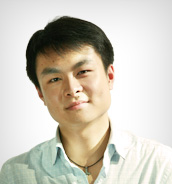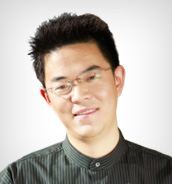Unit 6
Part Ⅱ Reading Comprehension
(35 minutes)
Directions: There are 4 reading passages in this part. Each passage is followed by some questions or unfinished statements. For each of them there are four choices marked A), B), C) and D). You should decide on the best choice and mark the corresponding letter on the Answer Sheet with a single line through the centre.
Passage One
Questions 21 to 25 are based on the following passage:
The process of perceiving other people is rarely translated (to ourselves or others) into cold, objective terms. “She was 5 feet 8 inches tall, had fair hair, and wore a colored skirt.” More often, we try to get inside the other person to pinpoint his or her attitudes, emotions, motivations, abilities, ideas and characters. Furthermore, we sometimes behave as if we can accomplish this difficult job very quickly — perhaps with a two-second glance.
We try to obtain information about others in many ways. Berger suggests several methods for reducing uncertainties about others: watching, without being noticed, a person interacting with others, particularly with others who are known to you so you can compare the observed person's behavior with the known others' behavior; observing a person in a

social behavior is relatively unrestrained or where a wide variety of behavioral responses are called for; deliberately structuring the physical or social environment so as to observe the person's responses to specific stimuli; asking people who have had or have frequent contact with the person about him or her; and using various strategies in face-to-face interaction to uncover information about another person — questions, self-disclosures (自我表露),and so on. Getting to know someone is a never-ending task, largely because people are constantly changing and the methods we use to obtain information are often imprecise. You may have known someone for ten years and still know very little about him. If we accept the idea that we won't ever fully know another person, it enables us to deal more easily with those things that get in the way of accurate knowledge such as secrets and deceptions. It will also keep us from being too surprised or shocked by seemingly inconsistent behavior. Ironically (讽刺性地), those things that keep us from knowing another person too well (e.g., secrets and deceptions) may be just as important to the development of a satisfying relationship as those things that enable us to obtain accurate knowledge about a person (e.g., disclosures and truthful statements).
21. The word “pinpoint” (para. 1, Line 3) basically means .
A) appreciate B) obtain C) interpret D) identify
22. What do we learn from the first paragraph?
A) People are better described in cold, objective terms.
B) The difficulty of getting to know a person is usually underestimated.
C) One should not judge people by their appearances.
D) One is usually subjective when assessing other people's personality.
23. It can be inferred from Berger's suggestions that .
A) People do not reveal their true self on every occasion.
B) in most cases we should avoid contacting the observed person directly.
C) the best way to know a person is by making comparisons.
D) face-to-face interaction is the best strategy to uncover information about a person
24. In developing personal relationships, secrets and deceptions, in the author's opinion, are .
A) personal matters that should be seriously dealt with
B) barriers that should be done away with.
C) as significant as disclosures and truthful statements
D) things people should guard against
25. The author's purpose in writing the passage is .
A) to give advice on appropriate conduct for social occasions
B) to provide ways of how to obtain information about people
C) to call the reader's attention to the negative side of people's characters
D) to discuss the various aspects of getting to know people
Questions 26 to 30 are based on the following passage:
The competition among producers of personal computers is essentially a race to get the best, most innovative products to the marketplace. Marketers in this environment frequently have to make a judgment as to their competitors' role when making marketing strategy decisions. If major competitors are changing their products, then a marketer may want to follow suit to remain competitive. Apple Computer, Inc. has introduced two new, faster personal computers, the Mackintosh Ⅱ and Mackintosh SE, in anticipation of the introduction of a new PC by IBM, one of Apple's major competitors.
Apple's new computers are much faster and more powerful than its earlier models. The improved Mackintosh is able to run programs that previously were impossible to run on an Apple PC, including IBM-compatible (兼容的) programs. This compatibility feature illustrates computer manufacturers' new attitude of giving customers the features they want. Making Apple computers capable of running IBM software is Apple's effort at making the Mackintosh compatible with IBM computers and thus more popular in the office, where Apple hopes to increase sales. Users of the new Apple can also add accessories (附件) to make their machines specialize in specific uses, such as engineering and writing.
The new computers represent a big improvement over past models, but they also cost much more. Company officials do not think the higher price will slow down buyers who want to step up to a more powerful computer. Apple wants to stay in the High-price end of the personal computer market to finance research for even faster, more sophisticated computers.
Even though Apple and IBM are major competitors, both companies realize that their competitor's computers have certain features that their own models do not. The Apple line has always been popular for its sophisticated color graphics (图形), whereas the IBM machines have always been favored in offices. In the future, there will probably be more compatibility between the two companies' products, which no doubt will require that both Apple and IBM change marketing strategies.
26. According to the passage, Apple Computer, Inc, has introduced the Mackintosh Ⅱ and the Mackintosh SE because .
A) IBM is changing its computer models continuously
B) it wants to make its machines specialize in specific uses
C) it wants to stay ahead of IBM in the competitive computer market
D) it expects its major competitor IBM to follow its example
27. Apple hopes to increase Mackintosh sales chiefly by .
A) making its new models capable of running IBM software
B) improving the color graphics of its new models
C) copying the marketing strategies of IBM
D) giving the customers what they want
28. Apple sells its new computer models at a high price because .
A) they have new features and functions
B) they are more sophisticated than other models
C) they have new accessories attached
D) it wants to accumulate funds for future research
29. It can be inferred from the passage that both Apple and IBM try to gain a competitive advantage by .
A) copying each other's technology
B) incorporating features that make their products distinctive
C) making their computers more expensive
D) making their computers run much faster
30. The best title for the passage would be .
A) Apple's Efforts to Stay Ahead of IBM C) Apple's New personal Computers
B) Apple's New Computer Technology D) Apple's Research Activities
Questions 31 to 35 are based on the following passage:
It is a curious paradox that we think of the physical sciences as “hard”, the social sciences as “soft”, and the biological sciences as somewhere in between. This is interpreted to mean that our knowledge of physical systems is more certain than our knowledge of biological systems, and these in turn are more certain than our knowledge of social systems. In terms of our capacity to sample the relevant universes, however, and the probability that our images of these universes are at least approximately correct, one suspects that a reverse order is more reasonable. We are able to sample earth's social systems with some degree of confidence that we have a reasonable sample of the total universe being investigated. Our knowledge of social systems, therefore, while it is in many ways extremely inaccurate, is not likely to be seriously overturned by new discoveries. Even the folk knowledge in social systems on which ordinary life is based in earning, spending, organizing, marrying, taking part in political activities, fighting and so on, is not very dissimilar from the more sophisticated images of the social system derived from the social sciences, even though it is built upon the very imperfect samples of personal experience.
In contrast, our image of the astronomical universe, or even of earth's geological history, can easily be subject to revolutionary changes as new data comes in and new theories are worked out. If we define the “security” our image of various parts of the total system as the probability of their suffering significant changes, then we would reverse the order of hardness and see the social sciences as the most secure, the physical sciences as the least secure, and again the biological sciences as somewhere in between. Our image of the astronomical universe is the least secure of all simply because we observe such a fantastically small sample of it and its record-keeping is trivial as compared with the rich records of the social systems, or even the limited records of biological systems. Records of the astronomical universe, despite the fact that we see distant things as they were long ago, are limited in the extreme.
Even in regard to such a close neighbour as the moon, which we have actually visited, theories about its origin and history are extremely different, contradictory, and hard to choose among. Our knowledge of physical evolution is incomplete and highly insecure.
31. The word “paradox”(Para. 1, Line 1) means “ ”
A) implication B) contradiction C) interpretation D) confusion
32. According to the author, we should reverse our classification of the physical sciences as “hard” and the social sciences as “soft” because .
A) a reverse ordering will help promote the development of the physical sciences
B) our knowledge of physical systems is more reliable than that of social systems
C) our understanding of the social systems is approximately correct
D) we are better able to investigate social phenomena than physical phenomena
33. The author believes that our knowledge of social systems is more secure than that of physical systems because .
A) it is not based on personal experience
B) new discoveries are less likely to occur in social sciences
C) it is based on a fairly representative quantity of data
D) the records of social systems are more reliable
34. The chances of the physical sciences being subject to great changes are the biggest because .
A) contradictory theories keep emerging all the time
B) new information is constantly coming in
C) the direction of their development is difficult to predict
D) our knowledge of the physical world is inaccurate
35. We know less about the astronomical universe than we do about any social system because .
A) theories of its origin and history are varied
B) our knowledge of it is highly insecure
C) only a very small sample of it has been observed
D) few scientists are involved in the study of astronomy
Questions 36 to 40 are based on the following passage:
In the early days of nuclear power, the United States made money on it. But today opponents have so complicated its development that no nuclear plants have been ordered or built here in 12 years.
The greatest fear of nuclear power opponents has always been a reactor “meltdown”(堆内熔化). Today, the chances of a meltdown that would threaten U.S. public health are very little. But to even further reduce the possibility, engineers are testing new reactors that rely not on human judgment to shut them down but on the laws of nature. Now General Electric is already building two advanced reactors in Japan. But don't expect them ever on U.S. shores unless things change in Washington.
The procedure for licensing nuclear power plants is a bad dream. Any time during, or even after, construction, an objection by any group or individual can bring everything to a halt while the matter is investigated or taken to court. Meanwhile, the builder must add nice-but-not-necessary improvements, some of which force him to knock down walls and start over. In every case where a plant has been opposed, the Nuclear Regulation Commission has ultimately granted a license to construct or operate. But the victory often costs so much that the utility ends up abandoning the plant anyway.
A case in point is the Shoreham plant on New York's Long Island. Shoreham was a virtual twin to the Millstone plant in Connecticut, both ordered in the mid-'60s. Millstone, completed for $101 million, has been generating electricity for two decades. Shoreham, however, was singled out by anti-nuclear activists who, by sending in endless protests, drove the cost over $5 billion and delayed its use for many years.
Shoreham finally won its operation license. But the plant has never produced a watt of power. Governor Mario Cuomo, an opponent of a Shoreham start-up, used his power to force New York's public-utilities commission to accept the following settlement: the power company could pass the cost of Shoreham along to its consumers only if it agreed not to operate the plant! Today, a perfectly good facility, capable of servicing hundreds of thousands of homes, sits rusting.
36. What has made the procedure for licensing nuclear power plants a bad dream? A) The inefficiency of the Nuclear Regulation commission.
B) The enormous cost of construction and operation.
C) The length of time it takes to make investigations.
D) The objection of the opponents of nuclear power.
37. It can be inferred from Paragraph 2 that .
A) it is not technical difficulties that prevent the building of nuclear power plants in the U.S.
B) there are not enough safety measures in the U.S. for running new nuclear power plants
C) there are already more nuclear power plants than necessary in the U.S.
D) the American government will not allow Japanese nuclear reactors to be installed in the U.S.
38. Any objection, however trivial it may be, can .
A) force the power companies to cancel the project
B) delay the construction or operation of a nuclear plant
C) cause a serious debate within the Nuclear Regulation Commission
D) take the builders to court
39. Governor Mario's chief intention in proposing the settlement was to .
A) stop the Shoreham plant from going into operation
B) help the power company to solve its financial problems
C) urge the power company to further increase its power supply
D) permit the shoreham plant to operate under certain conditions
40. The author's attitude towards the development of nuclear power is .
A) negative B) neutral C) positive D) questioning














